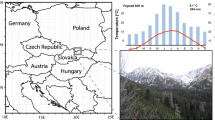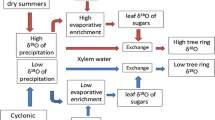Abstract
Tree-ring widths and stable carbon and oxygen isotopes of five European larch trees from Lötschental, Switzerland were investigated for the period 1900–2004. The objective was to test the suitability of each of these parameters for high-frequency climate reconstructions. This is of special interest with regard to the problem of cyclic larch budmoth (LBM) infestations of alpine larch trees. The results clearly demonstrate that tree-ring width chronologies are not suitable for high-frequency reconstructions because infestations lead to variably reduced tree-ring increments, largely suppressing climate signals. On the other hand, the stable isotope chronologies proved less affected by larch budmoth outbreaks, independent of the strength of the infestations. The correlation of the carbon isotopes with summer temperatures was especially high (r = 0.73) and with precipitation lower but nevertheless significant (r = −0.43). Oxygen isotopes were also correlated with summer temperature (r = 0.46); however, a certain perturbation of normal oxygen isotope signatures due to LBM outbreaks was evident. Contrary to tree-ring widths, none of the LBM outbreaks caused a significant disturbance of the current year’s isotopic climate signal and, most importantly, there were no delayed effects in the following years. Thus, stable carbon isotopes in tree-ring chronologies of the European larch provide an excellent opportunity for high-frequency temperature reconstructions.






Similar content being viewed by others
References
Aniol RW (1987) A new device for computer-assisted measurement of tree-ring widths. Dendrochronologia 5:135–141
Bachmann-Voegelin F (1984) Blatten im Lötschental.—Die traditionelle Kulturlandschaft einer Berggemeinde. Haupt, Bern
Baltensweiler W, Rubli D (1999) Dispersal: an important driving force of the cyclic population dynamics of the larch bud moth, Zeiraphera diniana Gn. For Snow Landsc Res 74:3–153
Bjørnstad ON, Peltonen M, Liebhold AM, Baltensweiler W (2002) Waves of larch budmoth outbreaks in the European Alps. Science 298:1020–1023
Böhm R, Auer I, Brunetti M, Maugeri M, Nanni T, Schöner UW (2001) Regional temperature variability in the European Alps: 1760–1998 from homogenized instrumental time series. Int J Climatol 21:1779–1801
Büntgen U, Esper J, Frank DC, Nicolussi K, Schmidhalter M (2005) A 1052-year tree-ring proxy for Alpine summer temperatures. Clim Dyn 25:141–153
Büntgen U, Frank DC, Nievergelt D, Esper J (2006) Summer temperature variations in the European Alps, AD 755–2004. J Clim 19:5606–5623
Büntgen U, Frank DC, Liebhold A, Johnson D, Carrer M, Urbinati C, Grabner M, Nicolussi K, Levanic T, Esper J (2009) Three centuries of insect outbreaks across the European Alps. New Phytol 182:929–941
Carrer M, Urbinati C (2004) Age-dependent tree-ring growth responses to climate in Larix decidua and Pinus cembra. Ecology 85:730–740
Carrer M, Urbinati C (2006) Long-term change in the sensitivity of tree-ring growth to climate forcing in Larix decidua. New Phytol 170:861–872
Dungan RJ, Turnbull MH, Kelly D (2007) The carbon costs for host trees of a phloem-feeding herbivore. J Ecol 95:603–613
Edwards TWD, Fritz P (1986) Assessing meteoric water composition and relative humidity from 18O and 2H in wood cellulose: palaeoclimatic implications from southern Ontario. Can Appl Geochem 1:715–723
Farquhar GD, Lloyd J (1989) Carbon and oxygen isotope effects in the exchange of carbon dioxide between terrestrial plants and the atmosphere. In: Ehleringer JR, Hall AE, Farquhar GD (eds) Stable isotopes and plant carbon/water relations. Academic Press, San Diego
Farquhar GD, O’Leary MH, Berry JA (1982) On the relationship between carbon isotope discrimination and the intercellular carbon dioxide concentration in leaves. Aust J Plant Physiol 9:121–137
Fischer F (1980) Verjüngungszustand und Jungwaldaufbau im Gebirgswald—Einige Beispiele aus dem Lötschental. Beih Schweiz Z Forstwes 67
Fischlin A (1982) Analyse eines Wald-Insekten-Systems: Der subalpine Lärchen-Arvenwald und der graue Lärchenwickler Zeiraphera diniana Gn. (Lep., Tortricidae), dissertation, ETH No. 6977, Swiss Federal Institute of Technology, Zürich
Francey RJ, Allison CE, Etheridge DM, Trudinger CM, Enting IG, Leuenberger MC, Langenfelds RL, Michel E, Steele LP (1999) A 1000 year high precision of δ13C in atmospheric CO2. Tellus 51B:170–193
Frank DC, Esper J (2005) Temperature reconstructions and comparisons with instrumental data from a tree-ring network for the European Alps. Int J Climatol 25:1437–1454
Friedli H, Loetscher H, Oeschger H, Siegenthaler U, Stauffer (1986) Ice core record of the 13C/12C ratio of atmospheric CO2 in the past two centuries. Nature 324:237–238
Fritts HC (1976) Tree rings and climate. Academic Press, London
Haavik L, Stephen F, Fierke M, Salisbury V, Leavitt SW, Billings S (2008) Tree-ring δ13C and historic growth patterns as indicators of Northern red oak (Quercus rubra Fagaceae) susceptibility to red oak borer (Enapholodes rufulus (Haldeman) (Coleoptera: Cerambycidae)). For Ecol Manage 255:1501–1509
Helle G, Schleser GH (2004) Beyond CO2-fixation by RUBISCO—an interpretative of 12C/13C variations in tree rings from novel intra-seasonal studies on broadleaf trees. Plant Cell Environ 27:367–380
Ikeda T (1983) Maximum principle in finite element models for convection-diffusion phenomena. Mathematics Studies 76, Lecture Notes in Numerical and Applied Analysis, vol 4. North-Holland, Amsterdam
Kaennel M, Schweingruber FH (1995) Multilingual glossary of dendrochronology. Swiss Federal Institute for Forest, Snow and Landscape Research, Birmensdorf
Keeling CD (1979) Recent trends of 13C/12C ratio of carbon dioxide. Nature 277:121–123
Keeling CD, Whorf TP (1991) Atmospheric CO2 records from sites in the SIO air sampling network. In: Boden et al (eds) Trends 91: a compendium of data on global change. Carbon Dioxide Information Analysis Center, Oak Ridge
Keeling CD, Bacastow RB, Tans P (1980) Predicted shift in the 13C/12C of atmospheric carbon dioxide. Geophys Res Lett 7(7):505–508
Kürschner WM (1996) Leaf stomata as biosensors of paleoatmospheric CO2-levels, dissertation, University of Utrecht
Leuenberger M, Siegenthaler U, Langway C (1992) Carbon isotope composition of atmospheric CO2 during the last ice age from an Antarctic ice core. Nature 357:488–490
Lipp J, Trimborn P, Edwards T, Waisel J, Yakir D (1996) Climatic effects on the delta O-18 and delta C-13 of cellulose in the desert tree Tamarix Jordanis. Geochim Cosmochim Acta 60(17):3305–3309
Mitchell JM Jr, Dzerdzeyevskii B, Flohn H, Hofmeyr WL, Lamb HH, Rao KN, Wallen CC (1966) Climatic change. WMO technical note 79. World Meteorological Organization, Geneva
Neftel A, Friedli H, Moor H, Lötscher H, Oeschger H, Siegenthaler U, Stauffer B (1990) Atmospheric carbon dioxide concentration—historical record, Siple Station. In: Boden et al (eds) Trends 90: a compendium of data on global change. Carbon Dioxide Information Analysis Center, Oak Ridge
Neuwirth B (1998) Dendroklimatologische Studien im Lötschental/Schweiz. Visuelle Jahrringparameter subalpiner Fichten in Abhängigkeit von Höhenlage, Exposition und Standortverhältnissen. Diplomarbeit, Geographisches Institut der Rheinischen Friedrich- Wilhelms-Universität, Bonn
Neuwirth B (2005) Interannuelle Klima/Wachstums–Beziehungen zentraleuropäischer Bäume von AD1901 bis 1971 – eine dendroklimatologische Netzwerkanalyse, dissertation, Geographisches Institut der Rheinischen Friedrich-Wilhelms-Universität, Bonn
Ott E (1978) Über die Abhängigkeit des Radialzuwachses und der Oberhölzer bei Fichte und Lärche von der Meereshöhe und Exposition im Lötschental. Schweiz Z Forst 129:169–193
Petitcolas V, Rolland C (1996) Dendroecological study of three subalpine conifers in the region of Briançon (French Alps). Dendrochronologia 14:147–153
Rinn F (2003) TSAP-Win professional time series analysis and presentation for dendrochronology and related applications. Version 0.3, Quick Reference
Rolland C, Petitcolas V, Michalet R (1998) Changes in radial tree growth for Picea abies, Larix decidua, Pinus cembra and Pinus uncinata near the alpine timberline since 1750. Trees 13:40–53
Rolland C, Baltensweiler W, Petitcolas V (2001) The potential for using Larix decidua ring widths in reconstructions of larch budmoth (Zeiraphera diniana) outbreak history: dendrochronological estimates compared with insect surveys. Trees 15:414–424
Turchin P, Wood SN, Ellner SP, Kendall BE, Murdoch WW, Fischlin A, Casas J, McCauley E, Briggs CJ (2003) Dynamical effects of plant quality and parasitism on population cycles of larch budmoth. Ecology 84:1207–1214
Weber U (1997) Dendrochronological reconstruction and interpretation of larch budmoth (Zeiraphera diniana) outbreaks in two central alpine valleys of Switzerland from 1470–1990. Trees 11:277–290
Wilson AT, Grinsted MJ (1977) 12C/13C in cellulose and lignin as paleothermometers. Nature 265:133–135
Yakir D, Issar A, Gat JR, Adar E, Trimborn P, Lipp J (1994) 13C and 18O of wood from the Roman siege rampart in Masada, Israel (AD 70–73): evidence for a less arid climate for the region. Geochim Cosmochim Acta 58:3535–3539
Acknowledgments
The authors wish to thank the staff of the Potsdam Dendro Laboratory at the Helmholtz-Zentrum Deutsches Geoforschungszentrum and the ICG-5 of the Forschungszentrum Juelich GmbH, namely Carmen Bürger, Werner Laumer and Holger Wissel for their active assistance within this project. We also thank Dr. Ulf Büntgen (WSL, Birmensdorf, CH) for his support during the field work. This research was partly funded by the EU FP5 project ISONET (Contract EV K2-2001-00237) and EU FP6 project MILLENNIUM (GOCE 017008).
Author information
Authors and Affiliations
Corresponding author
Additional information
Communicated by S. Leavitt.
Rights and permissions
About this article
Cite this article
Weidner, K., Heinrich, I., Helle, G. et al. Consequences of larch budmoth outbreaks on the climatic significance of ring width and stable isotopes of larch. Trees 24, 399–409 (2010). https://doi.org/10.1007/s00468-010-0421-1
Received:
Revised:
Accepted:
Published:
Issue Date:
DOI: https://doi.org/10.1007/s00468-010-0421-1




